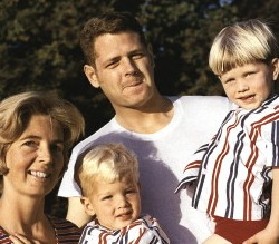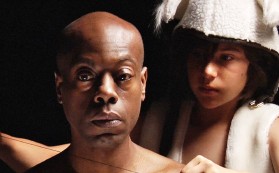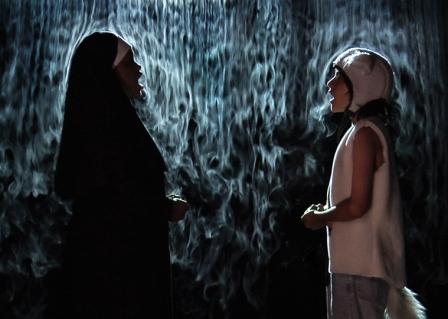Although the arts would seem to be the place most likely to accept transgender artists and transgender subject matter, other than screenings at film festivals the path to distribution can be a rocky one. Associated Press reports that the National Film Board of Thailand recently banned Insects in the Back Yard, a film about a transgender father raising two children, because the film contained a scene in which two men have sex (which made it seem immoral and pornographic to members of the film board).
Claiming that the film was partly based on her own life, the film's 37-year-old director, Tanwarin Sukkhapisit (who was born as a boy and started cross-dressing in her teens) noted that:
"The problem with my film wasn't that it was a gay-themed movie, because there are many gay comedies allowed in Thailand. My movie was banned because it was a serious movie. It showed there can be real problems when society cannot accept sexual differences."
Three remarkable films (one American, one Canadian, and one from New Zealand) take new and exciting approaches to examining issues of gender. When seen separately, they are remarkable pieces of work that force viewers to think "outside the box." When considered as part of an emerging area of the arts, they point to astonishing new possibilities.
For many people, Felicity Huffman's performance in Transamerica was the first time they had been forced to deal seriously with questions of gender identity. Unlike many gay documentaries (which deal with the history of political and social discrimination against LGBT people), Prodigal Sons focuses on a single family's unique challenges.
On the surface, Montana's McKerrow family looked like it had everything going for it. The father was a much-loved doctor practicing medicine in the state capital of Helena. After having difficulty conceiving a child, he and his wife decided to adopt a little boy. No sooner did Marc arrive in their home than his adoptive mother got pregnant with the first of two beautiful sons. I doubt this picture of the three children could fail to bring a smile to anyone's face. They look perfectly adorable.

This picture, taken from the family album, seems equally noncontroversial.

That is, of course, until one questions the effect of genetics on a nuclear family. The two sons born to Mrs. McKerrow both turned out to be gay. A strapping young quarterback, Paul McKerrow was the tall, blond, athletic captain of the football team who was also class president. Although his peers named Paul the person most likely to succeed, none of them knew that he was dogged by a nagging secret.
After leaving Montana, Paul underwent gender reassignment surgery and has been living and working successfully in New York. Paul became Kimberly Reed, the filmmaker/editor who decided to focus her lens on a trip back to Montana to attend a 20-year high school reunion.
Life plays strange tricks on people. Reed's documentary turns out to be about so much more than the challenges she has faced as a transgender person. Her older (adopted) brother Marc suffered an automobile accident many years ago which resulted in a form of mental illness that can make him extremely antagonistic if he is not on his medications.
Held back for a year in elementary school (and having never graduated from high school), Marc has always been haunted by his inability to compete with his athletic brother (who ended up in the same grade and became a star quarterback). As a result, Marc has been battling the ghost of his long-lost brother, Paul McKerrow, for years. Their high school reunion reignites the flames of doubt that Kim refers to as "the ghost of the man Marc could never be and Kim never wanted to be."
Kim and Marc's younger brother Todd (who is also gay) now lives in San Diego. But when the family reunites at their mother Carol's home, tensions quickly flare. If the sibling rivalry isn't enough to strain family relations, Marc's feeling that he has been cheated out of his life (due to the combination of having a different genetic history and having suffered brain damage in an automobile accident) is a wound that simply will not heal. His history becomes even more complicated with the discovery that he is the grandson of Orson Welles and Rita Hayworth.
A trip to Croatia to visit Oja Kodar (who was the soul-mate of the great actor for the last 24 years of his life) helps to give Marc a better sense of self. However, once Marc and Kim return to America, his mental illness starts to become unmanageable and an eruption of domestic violence leads to his institutionalization. In her director's statement, Reed explains that:
"I started out making a film about my adopted brother's journey to discover his new lineage. It was undeniably a great story, a real-life fairy tale. I also felt guilty that life had been easy for me but not for Marc. I imagined that by celebrating his amazing tale I could ease his pain and maybe heal our relationship. I thought I'd be making a film about the second chapter in our lives. Little did I know we weren't done with the first.
Anyone who has met Marc will tell you that you can't tell his story without telling mine. Our rivalry growing up was the most important dynamic in his life and remains so to this day. So I knew I'd end up in this film, but I had no idea it would become the personal journey it did.
When you change your sex, you get tremendous pressure to bury your past, to let it disappear like the 'M' that used to be on your driver's license. If you pass well in your new gender, the pressure is even stronger, especially from other transgender people who see passing as the Holy Grail. Returning to your past, much less reveling in it, is unthinkable. Before making this film, I shared that view.
But as the film evolved, and Marc and I began to have a relationship again, he was the only one who wouldn't let me get away with forgetting my past. I wanted Marc to let my male past die -- as I had -- but he had enshrined this history and even insisted on cherishing remnants of it. As much as I resisted this, I couldn't ignore the kernel of truth in what he was saying: I had to stop renouncing my history.
I started out believing this film was about Marc's quest for identity, but it was about my own. I thought my transition was complete, but instead Marc taught me I was only halfway, and that I had to somehow resurrect the first half of my life I had buried alive. This freed me to return home and reclaim my past. Though my situation is rare, everyone I know who has a sibling relates to the dynamic between Marc and me, and to my desire for my family to recognize who I've become instead of who I was when I left home.
Prodigal Sons has a deep reserve of high-octane dramatic fuel, but the film is so much more than its astonishing characters or the explosive moments we caught on camera. What sets this film apart is its exploration of the universal truths every family grapples with. In the end, this film is quite simply about love, and how one family faces challenges and triumphs that no one would have ever imagined."
The challenges Kim faces as a transgender almost seem small compared to the need for her to be the deciding force in her family following her father's death -- and occasionally the only one who is still able or willing to communicate with Marc after he enters a mental facility. Reed's documentary will unnerve you, astound you, and leave you overwhelmed with compassion for Kim and her mother. Here's the trailer:
* * * * * * * * * * *
In Kirsty MacDonald's mind-blowing documentary from New Zealand entitled Assume Nothing, we meet some amazing men and women who have used their own definitions of gender as a major focus for their art. They include:
- Mani Bruce Mitchell, born more than 50 years ago as a hermaphrodite. Mani discusses the shame she was always made to feel during her childhood about her body.
- Shigeyuki Kihara, a Japanese-Samoan performance artist and photographer who identifies as a Fa'afafine (a third gender specific to Samoan culture). Whether performing onstage in Sydney, Australia, or having her work on display at New York's Metropolitan Museum of Art, Kihara sees herself as normal and the rest of the world as needing to catch up. She believes that cisgenderism is the alternative gender identity to transgenderism (and not the other way around).
- Jack Byrne, a New Zealand transman poet and human rights activist who takes great pride in his skill as both a drag king and drag queen.
- Rebecca Swan, a red-headed professional photographer whose book of portraits entitled Assume Nothing forces viewers to question their views about gender identity. "Becks" has also become Jack's domestic partner.
- Ema Lyon, a performance artist who likes to play with androgynous images. Ema describes herself using the gender neutral Maori pronoun "ia" and the indigenous queer term "takataapui." Happy to be photographed in very masculine clothes and settings, Ema also poses for Swan's camera while pregnant.

What makes this documentary different from so many others is that many of its subjects are artist-activists whose careers have been made by building on their own definitions of gender (rather than being pigeonholed by traditional gender expectations). The fact that many of them are extremely creative talents means that the quality of work seen in MacDonald's film -- including some superb animation sequences -- is often breathtaking.
The heavy influence of Maori, Samoan, and Japanese cultures (where third gender or intersex people are fully accepted as a part of the natural spectrum of sexuality) puts Assume Nothing into a class all by itself. This is a documentary with a clear artistic vision that benefits from the vision of some clearly talented artists.
MacDonald's film is dramatically challenging, wildly indulgent, and unflinching in its highly intelligent examination of people whose lives have been shaped in new and unusual ways by their experiences with gender issues. The art seen in this film can easily hold its own against that of a legendary photographer like Robert Mapplethorpe, who also dealt with images of sexual ambiguity. Here's the trailer:
* * * * * * * * * * *
I would strongly urge anyone interested in zebras, Michael Jackson, pinatas, new music, opera, giraffes, pills, Maria Callas, model trains, political protests, healthcare reform and/or survival instincts to watch Fig Trees: A Documentary Opera About Pills, Gertrude Stein & AIDS Activism. Created by John Greyson, who directed 1996's magnificent Lilies, this is a multimedia artistic triumph which combines a wide variety of performance styles.
Early memorable attempts to integrate film into staged opera productions include New York City Opera's 1975 production of Eric Wolfgang Korngold's rarely-performed Die Tote Stadt as well as the 1981 staging of Frederick Delius's hauntingly beautiful Fennimore and Gerda by the Opera Theatre of St. Louis. An accomplished filmmaker, Greyson has taken a unique approach to creating a video opera by merging the story of AIDS activism on two continents with the opera Four Saints In Three Acts (which opened on Broadway on February 20, 1934 with a libretto by Gertrude Stein and a score composed by Virgil Thomsen). As he explains in the press kit for Fig Trees:
"In 1999, South African AIDS activist Zackie Achmat went on a treatment strike, refusing to take his pills until they were widely available to all South Africans. This symbolic act became a cause célèbre, helping build his group Treatment Action Campaign (TAC) into a national movement -- yet with each passing month Zackie grew sicker.
Fig Trees is a documentary opera about AIDS activists Tim McCaskell of Toronto and Zackie Achmat of Capetown as they fight for access to treatment drugs. Documentary interviews, speeches, press conferences and demonstrations are sampled, taken apart, and set to music, replayed this time as operatic scenes. A surreal fictional narrative is intercut with the stories of their struggles against government and the pharmaceutical industry. In this fictional world, Gertrude Stein decides to write a tragic opera about Tim and Zackie and their saint-like heroism. She kidnaps them, transports them to Niagara Falls, and forces them to sing a series of complicated avant-garde vocal compositions. However, when Zackie ends his treatment strike and starts taking his pills, Gertrude realizes that there will be no more tragedy, and thus no more opera.
Fig Trees performs musical and political inversions on the music and words of Gertrude Stein's avant-garde classic opera Four Saints in Three Acts, singing it upside down and backwards. Using compositional techniques of chance, palindromes, and polyphony, Fig Trees finds points of political harmony and musical convergence in operatic and documentary sequences that profile the overlapping stories of various activists: Gugu Diamini, Stephen Lewis, Simon Nkoli, and most of all, Tim and Zackie. Featuring in the supporting cast a singing albino squirrel, an amputee husker, a ghostly male soprano, and St. Theresa of Avila, Fig Trees tells the story of Zackie's treatment strike in song and the larger story of the fight for pills on two continents, and across two decades, asking what does it mean for us to sing about AIDS?"

Easily the most ambitious multimedia opera project I've ever seen, Fig Trees stands in a class by itself. It is at once cinematically arresting, musically fascinating, politically relevant, and grandly entertaining in ways that would make Peter Sellars green with envy.
"We were definitely taking on opera as this conservative, elitist monolith," explains Greyson, "but on the other hand, trying to tease out a tendency that's sometimes forgotten, a tendency of resistance, a tendency of social activism buried within those surtitles and grand divas parking and barking on center stage."

To suggest that Greyson's film is a monumental achievement in the mixing of art genres with archival footage of real-life events would be a ridiculous understatement. This is a multicultural, multinational, and multimedia stunner that will wash over you and flood your senses (whether you are listening to the human voice in all its richness, witnessing Nelson Mandela don an HIV Positive T-shirt or watching some stunning animation sequences). Kudos to David Wall for a thrilling original score. Here's the trailer:
To read more of George Heymont go to My Cultural Landscape.
